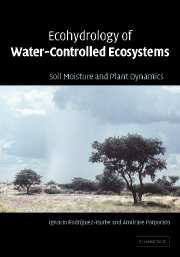Book contents
- Frontmatter
- Contents
- Foreword
- Preface
- 1 Introduction
- 2 Stochastic soil moisture dynamics and water balance
- 3 Crossing properties of soil moisture dynamics
- 4 Plant water stress
- 5 Applications to natural ecosystems
- 6 Coupled dynamics of photosynthesis, transpiration and soil water balance: from hourly to growing-season time scale
- 7 Plant strategies and water use
- 8 Seasonal and interannual fluctuations in soil moisture dynamics
- 9 Spatial scale issues in soil moisture dynamics
- 10 Hydrologic controls on nutrient cycles
- 11 Hydrologic variability and ecosystem structure
- References
- Species Index
- Subject Index
- Plate section
9 - Spatial scale issues in soil moisture dynamics
Published online by Cambridge University Press: 14 October 2009
- Frontmatter
- Contents
- Foreword
- Preface
- 1 Introduction
- 2 Stochastic soil moisture dynamics and water balance
- 3 Crossing properties of soil moisture dynamics
- 4 Plant water stress
- 5 Applications to natural ecosystems
- 6 Coupled dynamics of photosynthesis, transpiration and soil water balance: from hourly to growing-season time scale
- 7 Plant strategies and water use
- 8 Seasonal and interannual fluctuations in soil moisture dynamics
- 9 Spatial scale issues in soil moisture dynamics
- 10 Hydrologic controls on nutrient cycles
- 11 Hydrologic variability and ecosystem structure
- References
- Species Index
- Subject Index
- Plate section
Summary
This chapter focuses on the role of the spatial dimension in the dynamics of water balance, with special emphasis on vegetation response and the resulting feedbacks. In fact, notwithstanding the importance of the results obtained in the preceding chapters for the spatially lumped description of soil moisture, there are important cases in which the lateral and vertical fluxes of soil moisture may become essential in the water balance of a site.
The first part of the chapter will discuss the role of the vertical dimension in soil moisture dynamics. Historically, this issue has been the focus of much attention in the ecohydrology context, especially in connection with the vertical partitioning of the water available to vegetation. The well-known Walter hypothesis for tree–grass coexistence in savannas (Walter, 1971; Eagleson and Segarra, 1985) has perhaps contributed to overemphasize the role played by the vertical dimension in soil moisture dynamics on vegetation patterns (see Scholes and Walker, 1993; and also Chapter 11). Although some climate and soil combinations may indeed enhance the importance of the vertical dimension (e.g., as in the case of the Patagonia steppe or the shrublands of Arizona; Burgess, 1995; Paruelo and Sala, 1995; Golluscio et al., 1998), its relevance at the daily and seasonal time scale is usually less dramatic than at the hourly time scale, so that vertically integrated models of soil moisture dynamics can often provide an accurate enough description in what concerns plant stress and ecosystem function. Likewise, the interaction of the active soil layer with the water table is of secondary importance in most water-controlled ecosystems, unless strong topographic gradients or plants with very deep tap roots (phreatotypes) are present.
- Type
- Chapter
- Information
- Ecohydrology of Water-Controlled EcosystemsSoil Moisture and Plant Dynamics, pp. 268 - 305Publisher: Cambridge University PressPrint publication year: 2005



